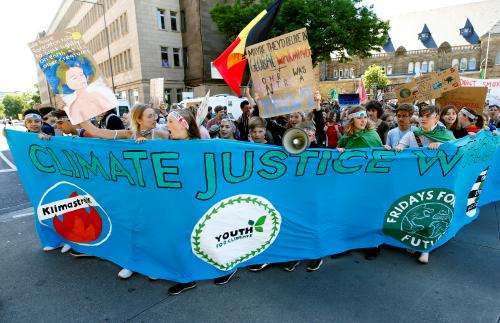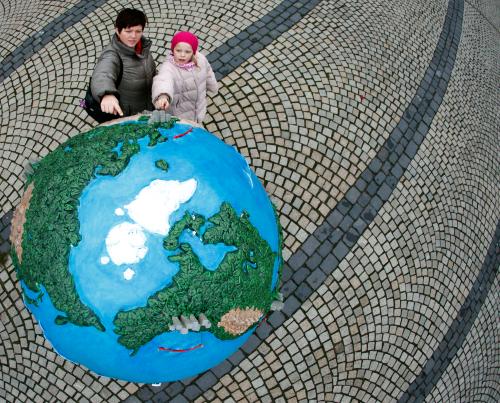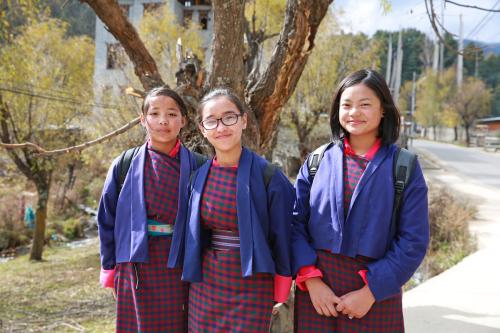This piece is a summary of the new report, “Girls’ education in climate strategies: Opportunities for improved policy and enhanced action in Nationally Determined Contributions.”
In Madrid this week, the 25th session of the Conference of the Parties to the United Nations Framework Convention on Climate Change (COP25) meets to finalize key decisions of the Paris Agreement before implementation next year. With countries set to submit revised Nationally Determined Contributions (NDCs—or, a country’s plan to reduce its greenhouse gas emissions and meet the goals of the Paris Agreement) in 2020, timing couldn’t be more opportune to bring to light a critical gap in climate strategies: NDCs are ignoring girls and overlooking the rights of children and youth, including their right to meaningfully participate in climate policymaking that affects them.
This is particularly important as next year the Doha Work Programme on Action for Climate Empowerment (ACE) is up for review. This Work Programme oversees efforts pertaining to education and training, both of which are positioned in the Paris Agreement and the U.N. Framework Convention on Climate Change (UNFCCC) as key to promoting the long-term change in lifestyle, mindsets, knowledge, and behaviors needed to realize a net-zero, climate-resilient future. However, national climate strategies like NDCs are doing little by way of laying out the groundwork for such efforts to translate into practice.
Our new report analyzed 160 NDCs and found that only three countries (Malawi, Venezuela, and Zambia) make explicit reference to girls, only one country (Zambia) mentions girls’ education, and no country formally recognizes the role that an investment in girls’ education could make in its climate strategy.
This is alarming, as research has illustrated how the achievement of universal girls’ education and girls’ rights can be a powerful force against further environmental damage and climate change. For starters, not only can a quality education help enhance girls’ “green skills” to better adapt to climate change, it can also prepare girls to participate and lead in traditionally male-dominated green sector jobs.
The absence of girls, however, is only part of the policy gap within current NDCs. Our study found that more than half of NDCs failed to mention children, youth, or future generations. Of the 42 percent that did reference children, the majority positioned children as a vulnerable group. Only seven NDCs actually positioned children as stakeholders to be included in climate decisionmaking and action. This suggests that in addition to the general insufficient ambition of the NDCs to limit climate change to 1.5 degrees and therefore protect children’s substantive rights, current pledges are also overlooking children’s “access” and rights to information, education, and participation.
Our analysis also illuminated disquieting results when it comes to action for climate empowerment. While both the UNFCCC (Article 6) and the Paris Agreement (Article 12) highlight the importance of education in climate action, we found that only 26 percent of NDCs reference education in a child-sensitive manner. In other words, education has been largely positioned in a passive role where it will not empower children and youth as critical stakeholders in climate decisionmaking and climate action today or in the future.
Recently, some actors have begun to call for the education sector to take a more prominent position in climate negotiations and action. A good starting place would be for the sector to tackle how national climate strategies have currently positioned education in one (or more) of four ways: 1) as a token activity intended to contribute to the success of efforts made by other sectors, like agriculture or waste management; 2) as an outcome that is impacted by weather-related disasters or the mitigation or adaptation contributions of another sector; 3) as a general activity without a specific target audience in mind; and 4) as a sector in need of support to achieve a country’s broader sustainable development goals—not necessarily a country’s climate strategy.
Perhaps most significantly, our analysis demonstrates that at a global level, some countries are shouldering the burden of climate action more than others. The Paris Agreement is unlike any other international climate treaty as it seeks to ensure that climate action upholds principles of justice, intergenerational equity, gender equality, human rights, and action for climate empowerment. However, the NDCs of “young” countries—those countries with a large under-15 population—are more likely to attend to intergenerational dimensions of climate change and climate action than “older” countries. Similarly, the most climate-vulnerable countries are more likely to address children and future generations and reference issues of education than the top carbon-emitting countries (see Table 1).
| Children and future generations | Education and skills | |
| Top 20 CO2 emitting countries | 5 (25%) | 7 (35%) |
| The rest of the world (142 countries) | 70 (49%) | 101 (71%) |
| The top 20 most climate-vulnerable countries | 12 (60%) | 15 (75%) |
Indeed, it is countries that are already experiencing the impact of rising sea levels, decreased air quality, and intensifying heat alongside ongoing challenges of economic development, poverty, and inequality that are tending to children and child-sensitive education. This includes countries like Qatar, Eritrea, Bahrain, Sudan, Myanmar, and India. Whether there is a gap between policy ambition and implementation is a matter for further study.
The absence of attention to girls, children, and youth is a reflection of broader bias within climate strategies that overemphasize contributions made by large-scale mitigation activities—activities which tend to be highly technical. Sociological considerations of justice, equity, and fairness remain political talking points that do not get translated into policy or practice. While pockets of climate stakeholders have become more vocal about the needs, rights, and concerns of children (and girls) in climate change, the large majority of climate policymakers fail to adequately consider children as important agents of change—a state of affairs which our study sadly confirms.
2020 will be an important year for the future of human society on this planet. An anticipated 185 countries are expected to submit new or revised NDCs. The ambition contained within individual NDCs will collectively determine whether efforts to limit global temperature rise to 1.5°C by 2100 will be successful. As such, it is imperative that national climate strategies include the most comprehensive and inclusive mitigation and adaptation efforts possible. Attention to action for climate empowerment for the most marginalized girls must be among them, as well as the recognition of the rights of present and future generations of children. To assure this happens, girls, children, and youth must be included in the process of climate negotiations and notably in the creation and revision of NDCs leading up to COP26 next year.
Note: See also the work of our partners at Plan International and UNICEF on this topic.










Commentary
National climate strategies are forgetting about girls, children, and youth
December 10, 2019